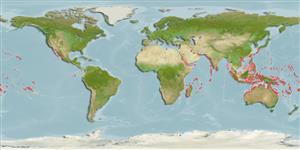>
Eupercaria/misc (Various families in series Eupercaria) >
Labridae (Wrasses) > Corinae
Etymology: Thalassoma: Greek, thalassa = the sea + Greek, soma = body; the colour of the sea (Ref. 45335).
More on author: Forsskål.
Environment: milieu / climate zone / depth range / distribution range
Ecologia
marinhas associadas(os) a recifes; intervalo de profundidade 0 - 10 m (Ref. 30573). Tropical; 32°N - 32°S
Indo-Pacific: Red Sea and East Africa (Ref. 4392) to the Hawaiian, Marquesan, and Easter islands, north to southern Japan, south to Lord Howe, Kermadec, and Rapa islands. Southeast Atlantic: southeast coast of South Africa (Ref. 4392). Replaced by Thalassoma virens in the Revillagigedo Islands (Ref. 37816).
Tamanho / Peso / Idade
Maturity: Lm ? range ? - ? cm
Max length : 46.0 cm TL macho/indeterminado; (Ref. 30573); peso máx. Publicado: 1.2 kg (Ref. 40637)
Espinhos dorsais (total): 8; Raios dorsais moles (total): 12-14; Espinhos anais 3; Raios anais moles: 10 - 12. T. purpureum and T. trilobatum have nearly identical initial phases (Ref. 1602). They differ slightly in details of the head markings, and T. purpureum has a slightly longer head, shorter pectoral fins, and attains a larger size (Ref. 1602, 48636). Females best distinguished by the 'V' mark on the snout (Ref. 48636). Initial phase with a vertical dark red line below front of eye usually with a branch to front of snout (Ref 9823).
Found almost exclusively in the surge zone of outer reef flats, reef margins, and rocky coastlines, down to a depth of about 10 m (Ref. 5213). Benthopelagic (Ref. 58302). Occur in groups of females that are spread out over large reef sections and dominated by few males. Males grow much larger than females (Ref. 48636). Feed on small invertebrates (crabs, sea urchins, brittlestars, mollusks), small fishes, echinoids, ophiuroids and polychaetes (Ref. 37816). Protogynous (Ref. 55080).
Life cycle and mating behavior
Maturidade | Reprodução | Desova | Ovos | Fecundidade | Larvas
Pelagic spawner.
Randall, J.E., G.R. Allen and R.C. Steene, 1990. Fishes of the Great Barrier Reef and Coral Sea. University of Hawaii Press, Honolulu, Hawaii. 506 p. (Ref. 2334)
Categoria na Lista Vermelha da IUCN (Ref. 130435)
Ameaça para o homem
Harmless
Utilização humana
Pescarias: pouco comercial; peixe desportivo: sim; Aquário: Espécies comerciais
Mais informação
ReferênciasAquaculturaPerfil para aquaculturaEstirpesGenéticaElectrophoresesHereditariedadeDoençasProcessamentoNutrientsMass conversion
ColaboradoresFotografiasStamps, Coins Misc.SonsCiguateraVelocidadeTipo de nataçãoÁrea branquialOutras referênciasCérebrosVisão
Ferramentas
Relatórios especiais
Descarregue XML
Fontes da internet
Estimates based on models
Preferred temperature (Ref.
123201): 24.6 - 29.3, mean 28.3 °C (based on 3134 cells).
Phylogenetic diversity index (Ref.
82804): PD
50 = 0.5000 [Uniqueness, from 0.5 = low to 2.0 = high].
Bayesian length-weight: a=0.00955 (0.00430 - 0.02123), b=3.06 (2.89 - 3.23), in cm total length, based on LWR estimates for this Genus-body shape (Ref.
93245).
Nível Trófico (Ref.
69278): 3.8 ±0.0 se; based on diet studies.
Resiliência (Ref.
120179): Médio, tempo mínimo de duplicação da população 1,4 - 4,4 anos (Preliminary K or Fecundity.).
Fishing Vulnerability (Ref.
59153): Moderate vulnerability (36 of 100).
Nutrients (Ref.
124155): Calcium = 42.4 [25.2, 69.5] mg/100g; Iron = 0.532 [0.303, 0.984] mg/100g; Protein = 18.8 [15.9, 21.1] %; Omega3 = 0.118 [0.076, 0.185] g/100g; Selenium = 23.1 [13.7, 42.7] μg/100g; VitaminA = 105 [31, 372] μg/100g; Zinc = 1.25 [0.88, 1.92] mg/100g (wet weight);
